Tianrui Liu
SMILENet: Unleashing Extra-Large Capacity Image Steganography via a Synergistic Mosaic InvertibLE Hiding Network
Mar 07, 2025Abstract:Existing image steganography methods face fundamental limitations in hiding capacity (typically $1\sim7$ images) due to severe information interference and uncoordinated capacity-distortion trade-off. We propose SMILENet, a novel synergistic framework that achieves 25 image hiding through three key innovations: (i) A synergistic network architecture coordinates reversible and non-reversible operations to efficiently exploit information redundancy in both secret and cover images. The reversible Invertible Cover-Driven Mosaic (ICDM) module and Invertible Mosaic Secret Embedding (IMSE) module establish cover-guided mosaic transformations and representation embedding with mathematically guaranteed invertibility for distortion-free embedding. The non-reversible Secret Information Selection (SIS) module and Secret Detail Enhancement (SDE) module implement learnable feature modulation for critical information selection and enhancement. (ii) A unified training strategy that coordinates complementary modules to achieve 3.0x higher capacity than existing methods with superior visual quality. (iii) Last but not least, we introduce a new metric to model Capacity-Distortion Trade-off for evaluating the image steganography algorithms that jointly considers hiding capacity and distortion, and provides a unified evaluation approach for accessing results with different number of secret image. Extensive experiments on DIV2K, Paris StreetView and ImageNet1K show that SMILENet outperforms state-of-the-art methods in terms of hiding capacity, recovery quality as well as security against steganalysis methods.
A Lightweight Deep Exclusion Unfolding Network for Single Image Reflection Removal
Mar 03, 2025Abstract:Single Image Reflection Removal (SIRR) is a canonical blind source separation problem and refers to the issue of separating a reflection-contaminated image into a transmission and a reflection image. The core challenge lies in minimizing the commonalities among different sources. Existing deep learning approaches either neglect the significance of feature interactions or rely on heuristically designed architectures. In this paper, we propose a novel Deep Exclusion unfolding Network (DExNet), a lightweight, interpretable, and effective network architecture for SIRR. DExNet is principally constructed by unfolding and parameterizing a simple iterative Sparse and Auxiliary Feature Update (i-SAFU) algorithm, which is specifically designed to solve a new model-based SIRR optimization formulation incorporating a general exclusion prior. This general exclusion prior enables the unfolded SAFU module to inherently identify and penalize commonalities between the transmission and reflection features, ensuring more accurate separation. The principled design of DExNet not only enhances its interpretability but also significantly improves its performance. Comprehensive experiments on four benchmark datasets demonstrate that DExNet achieves state-of-the-art visual and quantitative results while utilizing only approximately 8\% of the parameters required by leading methods.
Web Archives Metadata Generation with GPT-4o: Challenges and Insights
Nov 08, 2024



Abstract:Current metadata creation for web archives is time consuming and costly due to reliance on human effort. This paper explores the use of gpt-4o for metadata generation within the Web Archive Singapore, focusing on scalability, efficiency, and cost effectiveness. We processed 112 Web ARChive (WARC) files using data reduction techniques, achieving a notable 99.9% reduction in metadata generation costs. By prompt engineering, we generated titles and abstracts, which were evaluated both intrinsically using Levenshtein Distance and BERTScore, and extrinsically with human cataloguers using McNemar's test. Results indicate that while our method offers significant cost savings and efficiency gains, human curated metadata maintains an edge in quality. The study identifies key challenges including content inaccuracies, hallucinations, and translation issues, suggesting that Large Language Models (LLMs) should serve as complements rather than replacements for human cataloguers. Future work will focus on refining prompts, improving content filtering, and addressing privacy concerns through experimentation with smaller models. This research advances the integration of LLMs in web archiving, offering valuable insights into their current capabilities and outlining directions for future enhancements. The code is available at https://github.com/masamune-prog/warc2summary for further development and use by institutions facing similar challenges.
Image Captioning in news report scenario
Apr 02, 2024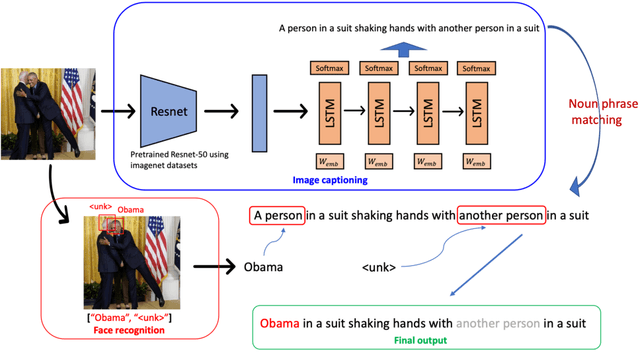
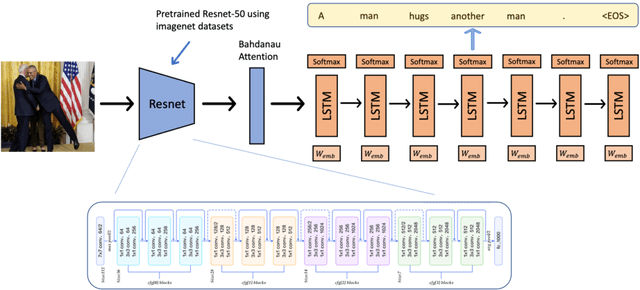


Abstract:Image captioning strives to generate pertinent captions for specified images, situating itself at the crossroads of Computer Vision (CV) and Natural Language Processing (NLP). This endeavor is of paramount importance with far-reaching applications in recommendation systems, news outlets, social media, and beyond. Particularly within the realm of news reporting, captions are expected to encompass detailed information, such as the identities of celebrities captured in the images. However, much of the existing body of work primarily centers around understanding scenes and actions. In this paper, we explore the realm of image captioning specifically tailored for celebrity photographs, illustrating its broad potential for enhancing news industry practices. This exploration aims to augment automated news content generation, thereby facilitating a more nuanced dissemination of information. Our endeavor shows a broader horizon, enriching the narrative in news reporting through a more intuitive image captioning framework.
Rumor Detection with a novel graph neural network approach
Apr 02, 2024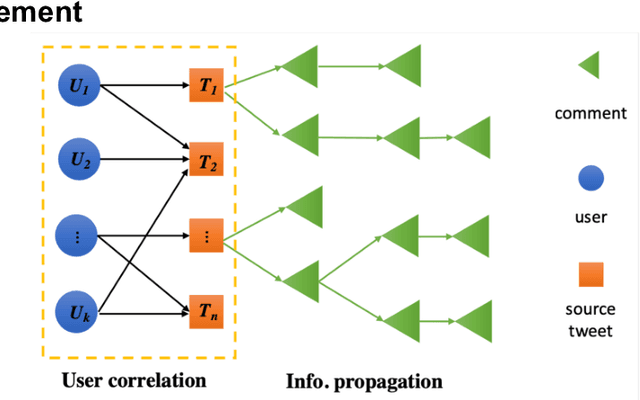
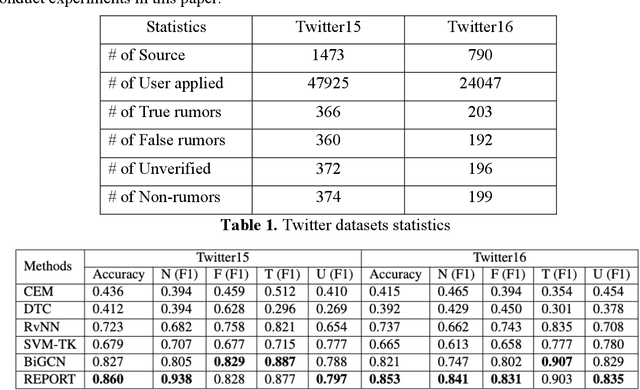

Abstract:The wide spread of rumors on social media has caused a negative impact on people's daily life, leading to potential panic, fear, and mental health problems for the public. How to debunk rumors as early as possible remains a challenging problem. Existing studies mainly leverage information propagation structure to detect rumors, while very few works focus on correlation among users that they may coordinate to spread rumors in order to gain large popularity. In this paper, we propose a new detection model, that jointly learns both the representations of user correlation and information propagation to detect rumors on social media. Specifically, we leverage graph neural networks to learn the representations of user correlation from a bipartite graph that describes the correlations between users and source tweets, and the representations of information propagation with a tree structure. Then we combine the learned representations from these two modules to classify the rumors. Since malicious users intend to subvert our model after deployment, we further develop a greedy attack scheme to analyze the cost of three adversarial attacks: graph attack, comment attack, and joint attack. Evaluation results on two public datasets illustrate that the proposed MODEL outperforms the state-of-the-art rumor detection models. We also demonstrate our method performs well for early rumor detection. Moreover, the proposed detection method is more robust to adversarial attacks compared to the best existing method. Importantly, we show that it requires a high cost for attackers to subvert user correlation pattern, demonstrating the importance of considering user correlation for rumor detection.
Particle Filter SLAM for Vehicle Localization
Feb 20, 2024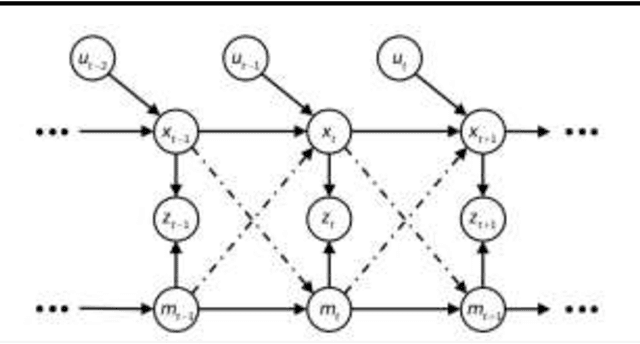
Abstract:Simultaneous Localization and Mapping (SLAM) presents a formidable challenge in robotics, involving the dynamic construction of a map while concurrently determining the precise location of the robotic agent within an unfamiliar environment. This intricate task is further compounded by the inherent "chicken-and-egg" dilemma, where accurate mapping relies on a dependable estimation of the robot's location, and vice versa. Moreover, the computational intensity of SLAM adds an additional layer of complexity, making it a crucial yet demanding topic in the field. In our research, we address the challenges of SLAM by adopting the Particle Filter SLAM method. Our approach leverages encoded data and fiber optic gyro (FOG) information to enable precise estimation of vehicle motion, while lidar technology contributes to environmental perception by providing detailed insights into surrounding obstacles. The integration of these data streams culminates in the establishment of a Particle Filter SLAM framework, representing a key endeavor in this paper to effectively navigate and overcome the complexities associated with simultaneous localization and mapping in robotic systems.
* 6 pages, Journal of Industrial Engineering and Applied Science
News Recommendation with Attention Mechanism
Feb 20, 2024Abstract:This paper explores the area of news recommendation, a key component of online information sharing. Initially, we provide a clear introduction to news recommendation, defining the core problem and summarizing current methods and notable recent algorithms. We then present our work on implementing the NRAM (News Recommendation with Attention Mechanism), an attention-based approach for news recommendation, and assess its effectiveness. Our evaluation shows that NRAM has the potential to significantly improve how news content is personalized for users on digital news platforms.
* 7 pages, Journal of Industrial Engineering and Applied Science
Mesh-based 3D Motion Tracking in Cardiac MRI using Deep Learning
Sep 05, 2022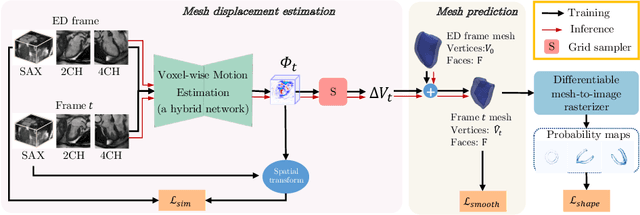
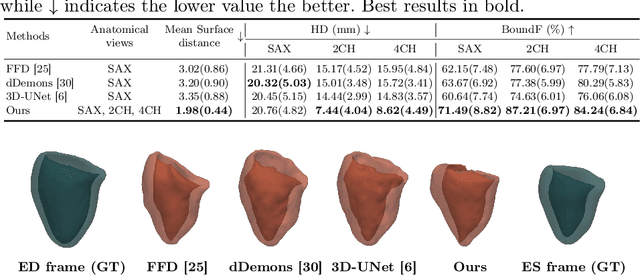
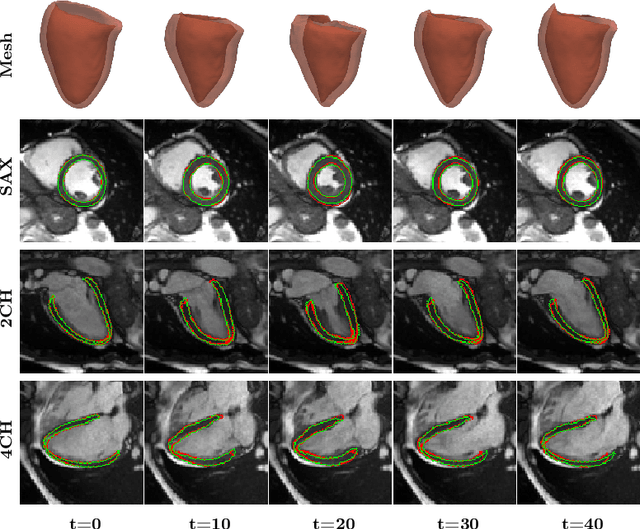

Abstract:3D motion estimation from cine cardiac magnetic resonance (CMR) images is important for the assessment of cardiac function and diagnosis of cardiovascular diseases. Most of the previous methods focus on estimating pixel-/voxel-wise motion fields in the full image space, which ignore the fact that motion estimation is mainly relevant and useful within the object of interest, e.g., the heart. In this work, we model the heart as a 3D geometric mesh and propose a novel deep learning-based method that can estimate 3D motion of the heart mesh from 2D short- and long-axis CMR images. By developing a differentiable mesh-to-image rasterizer, the method is able to leverage the anatomical shape information from 2D multi-view CMR images for 3D motion estimation. The differentiability of the rasterizer enables us to train the method end-to-end. One advantage of the proposed method is that by tracking the motion of each vertex, it is able to keep the vertex correspondence of 3D meshes between time frames, which is important for quantitative assessment of the cardiac function on the mesh. We evaluate the proposed method on CMR images acquired from the UK Biobank study. Experimental results show that the proposed method quantitatively and qualitatively outperforms both conventional and learning-based cardiac motion tracking methods.
Exploring Point-BEV Fusion for 3D Point Cloud Object Tracking with Transformer
Aug 10, 2022
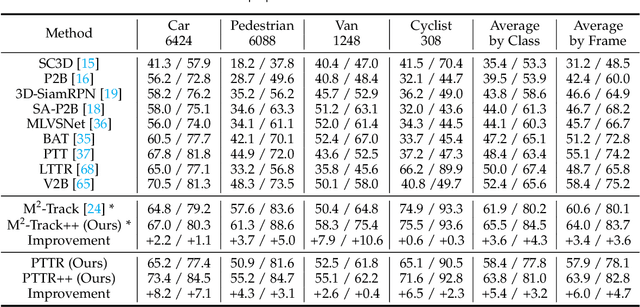


Abstract:With the prevalence of LiDAR sensors in autonomous driving, 3D object tracking has received increasing attention. In a point cloud sequence, 3D object tracking aims to predict the location and orientation of an object in consecutive frames given an object template. Motivated by the success of transformers, we propose Point Tracking TRansformer (PTTR), which efficiently predicts high-quality 3D tracking results in a coarse-to-fine manner with the help of transformer operations. PTTR consists of three novel designs. 1) Instead of random sampling, we design Relation-Aware Sampling to preserve relevant points to the given template during subsampling. 2) We propose a Point Relation Transformer for effective feature aggregation and feature matching between the template and search region. 3) Based on the coarse tracking results, we employ a novel Prediction Refinement Module to obtain the final refined prediction through local feature pooling. In addition, motivated by the favorable properties of the Bird's-Eye View (BEV) of point clouds in capturing object motion, we further design a more advanced framework named PTTR++, which incorporates both the point-wise view and BEV representation to exploit their complementary effect in generating high-quality tracking results. PTTR++ substantially boosts the tracking performance on top of PTTR with low computational overhead. Extensive experiments over multiple datasets show that our proposed approaches achieve superior 3D tracking accuracy and efficiency.
TransPillars: Coarse-to-Fine Aggregation for Multi-Frame 3D Object Detection
Aug 04, 2022



Abstract:3D object detection using point clouds has attracted increasing attention due to its wide applications in autonomous driving and robotics. However, most existing studies focus on single point cloud frames without harnessing the temporal information in point cloud sequences. In this paper, we design TransPillars, a novel transformer-based feature aggregation technique that exploits temporal features of consecutive point cloud frames for multi-frame 3D object detection. TransPillars aggregates spatial-temporal point cloud features from two perspectives. First, it fuses voxel-level features directly from multi-frame feature maps instead of pooled instance features to preserve instance details with contextual information that are essential to accurate object localization. Second, it introduces a hierarchical coarse-to-fine strategy to fuse multi-scale features progressively to effectively capture the motion of moving objects and guide the aggregation of fine features. Besides, a variant of deformable transformer is introduced to improve the effectiveness of cross-frame feature matching. Extensive experiments show that our proposed TransPillars achieves state-of-art performance as compared to existing multi-frame detection approaches. Code will be released.
 Add to Chrome
Add to Chrome Add to Firefox
Add to Firefox Add to Edge
Add to Edge